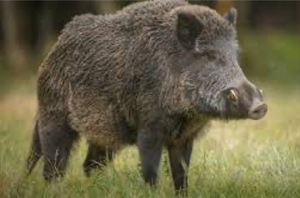
As in many areas across the Texas landscape and elsewhere in the nation, feral hog numbers are increasing. This includes the Plum Creek Watershed. These animals damage crops, livestock, pets, landscaping, and natural habitat in rural and urban areas alike.
Feral hogs also have the potential to contribute to water pollution by increasing the levels of sediment, nutrients, and bacteria in streams and lakes.
The Texas AgriLife Extension Service is cooperating with the Plum Creek Watershed Partnership to address this growing local issue. Working to provide information and assistance to watershed landowners, we may reduce the effects of feral hog activity.
Feral Hog Trap Loan Program
The Caldwell-Travis Soil & Water Conservation District, in conjunction with the Guadalupe-Blanco River Authority, is excited to announce a new Feral Hog Trap Loan Program available to Caldwell County landowners.
To participate in the program, landowners must:
- Be the landowner
- Be located in Caldwell County
- Complete an interest form to join the waitlist for available traps
- Drop off the completed form at the Lockhart NRCS office (111 E. MLK Jr Industrial Blvd., Lockhart, TX) or email the completed form to Sierra Murray (smurray@gbra.org)
- Submit a refundable deposit to ensure responsible trap use
- Provide their own bait
- Agree to follow provided guidelines for safe, humane, and effective trapping techniques
Traps are available on a first-come, first-served basis. During the 3-month loan, landowners are provided with a Pig Brig Trap system, all necessary hardware, and game camera. Loan participants will also receive educational materials for safe, humane, and effective trapping.
For more information, contact Sierra Murray at (830)557-7358 or smurray@gbra.org.
Funding for this effort is provided by the Guadalupe-Blanco River Authority and the Caldwell-Travis Soil & Water Conservation District.
Feral Hog Links
- Feral Hog Trap Loan Program Brochure
- Feral Hogs, Plum Creek, and You
- National Resources Institute and Texas A&M – Wild Pigs
- Coping with Feral Hogs
- National Extension Feral Hogs Community of Practice
- Wild Wonderings Blog (search “feral hog”)
- Texas AgriLife Extension Bookstore (search “feral hog”)
- Texas Parks and Wildlife Department Feral Hog Information
- Texas Animal Health Commission – Active Feral Swine Holding Facilities
- Texas Natural Resource Server (search “feral hog”)
Fact Sheets on Feral Hog Issues
Texas AgriLife Extension has developed publications for landowners on a variety of issues:
- Feral Hog Population Growth, Density and Harvest in Texas
- Using Fences to Exclude Feral Hogs from Wildlife Feeding Stations
- Feral Hogs Negatively Affect Native Plant Communities
- Feral Hog Laws and Regulations in Texas
- Feral Hogs and Disease Concerns
- Feral Hogs and Water Quality in Plum Creek
- Feral Hogs Impact Ground-nesting Birds
- Feral Hog Transportation Regulations
- Feral Hog Approved Holding Facility Guidelines in Texas
Capture Techniques
- Recognizing Feral Hog Sign — Spanish
- Corral Traps for Feral Hogs — Spanish
- Box Traps for Feral Hogs — Spanish
- Placing and Baiting Feral Hog Traps — Spanish
- Door Modifications for Feral Hog Traps — Spanish
- Snaring Feral Hogs — Spanish
- Making a Feral Hog Snare — Spanish
Feral hogs are not considered wildlife and are not classified as a game species in Texas. Instead, this exotic species is considered free-ranging livestock. Feral hogs and their damage are the responsibility of the landowner where they are found. As a result, landowners spend considerable time and money in attempt to manage these animals.
Once feral hogs are established in an area, complete eradication is almost impossible. There is no “silver bullet” or a single quick fix. However, by using multiple approaches, landowners and mangers can limit the size of feral hog populations and reduce the level of damage.
Each approach may be viewed as one option in the “toolbox” for feral hog management, and a combination of techniques will likely be needed to have a sustained effect and diminish feral hog impacts. For best results, these different techniques should be used simultaneously.